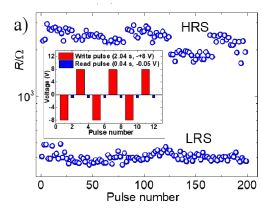
-
- to
Here you will find the paper by Monica Burriel
" The microelectronics industry is currently searching for reliable redox-based resistive switching (RS) memories which are filament-free, scale with the electrode size and do not require a high voltage electroforming step. Interface and volume type switching devices are the most promising memristors to achieve these challenging requirements, both for ReRAM (Resistive Random-Access Memories) non-volatile memory and neuromorphic computing applications. Here RS was investigated for the first time in the nanoionic memristors based on GdBaCo2O5+δ (GBCO), an oxide with high oxygen mobility. Non-filamentary and non-volatile reproducible RS was obtained when GBCO is sandwiched between Ag and LaNiO3 (LNO) electrodes. The observed bipolar RS could be successfully induced both by voltage sweeps and by pulses, showing asymmetric clock-wise hysteretic R(V) characteristics at room temperature. The temperature dependence of two independent devices in high and low resistance states (HRS and LRS) revealed a gradual decrease of the resistance difference between the two states on cooling from room temperature to 150 K and its increase below 100 K. Similarly, the R(V) switching curves obtained at low temperature showed the disappearance of the hysteresis at 150 K and its reappearance at lower temperatures. The superposition of volume and interface type RS mechanisms have proven to be responsible for the observed non-volatile change of the remnant resistance. The volume-type RS was related to the variation of the GBCO resistivity due to a change in oxygen content. The interface-type RS, on the other hand, was associated to the created electronic and ionic conduction barrier between GBCO and LNO bottom electrode. "


